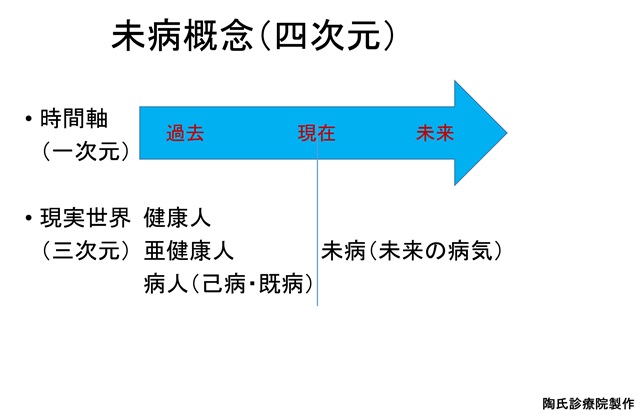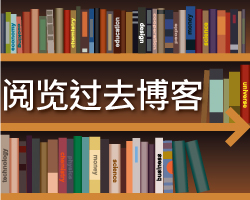2023-12-06
黄帝内经治未病陶氏疗法在日本临床应用25年研讨①
2023-12-06
黄帝内经治未病陶氏疗法在日本临床应用25年研讨②
2023-12-06
黄帝内经治未病陶氏疗法在日本临床应用25年研讨③
2023-12-06
黄帝内经治未病陶氏疗法在日本临床应用25年研讨④
2023-12-06
黄帝内经治未病陶氏疗法在日本临床应用25年研讨⑤
2023-12-06
黄帝内经治未病陶氏疗法在日本临床应用25年研讨⑥
2023-12-06
黄帝内经治未病陶氏疗法在日本临床应用25年研讨⑦
2023-12-06
黄帝内经治未病陶氏疗法在日本临床应用25年研讨⑧
2023-12-06
黄帝内经治未病陶氏疗法在日本临床应用25年研讨⑨
2023-12-06
黄帝内经治未病陶氏疗法在日本临床应用25年研讨⑩
2023-12-06
黄帝内经治未病陶氏疗法在日本临床应用25年研讨⑫
2023-12-06
黄帝内经治未病陶氏疗法在日本临床应用25年研讨⑪
2018-12-29
黄帝内经治未病的健康理念指导肝癌复发患者恢复健康病例报告(D2-1)
黄帝内经治未病陶氏疗法在日本临床应用25年研讨⑤
博客分类 论文
未病概念的维度
中国 《黄帝内经素问·四气调神大论》“是故圣人不治已病治未病,不治已乱治未乱,此之谓也。夫病已成而后药之,乱已成而后治之,譬犹渴而穿井,斗而铸锥,不亦晚乎”中第一次提出了未病和治未病的概念。此处的已病和未病中的未病,是疾病的时空标准。
日本 日本未病学会对未病有两种看法:西医的未病,没有主观症状,但检查发现异常;东洋医学(中医)的未病,有主观症状,但检查没有异常。日本的未病治疗对象,是健康者和亚健康者。丢失了既病(已病)患者。所以日本的未病定义,仅仅以疾病发生的时间为标准的简单理解。
未病的时间标准(时间是一维・狭义低维度):未病按西医的人体有无临床症状和检查异常,分有病和无病(没有异常发现)。西医对把有自我症状无临床检查异常,或没有自我症状有临床检查异常的分类为未病(未形成疾病),把无自我症状和无临床检查异常的分类为健康。所以按时间标准分类,人类分已病、未病和健康者三类。
未病的时空标准 (时间加空间是四维・广义高维度):疾病(已病)是表示在过去的时间空间,因各种原因导致的身体阴阳平衡失调,所以任何已病都是过去式。从现在时空开始,任何人,包括已病都存在未来的疾病,简称未病。利用这样的概念,治未病可以成为针对所有人群的医疗行为。黄帝内经的“圣人不治已病治未病”指的是不治过去的疾病,而是治疗未来的疾病,即治未病。具体的就是中国现在执行的治未病的四字方针:未病先防、己病早治、既病防变、瘥后防复。
黄帝内经的下医治病是对疾病的医疗目标,中医养生是对产生疾病个人的目标,上医治国是社会(全人类)的共同最高目标。临床照顾的患者治未病是社会人员的局部,中医的治未病应该面向社会整体的服务范围,让己病和无病的所有社会人都能享受到中医治未病的智慧结晶。
Dimensions of the Concept of Preventive Treatment of Disease
In China, the ❝Yellow Emperor’s Inner Canon Suwen - Four Qi Regulating God's Great Theory❞ addresses the sage's approach to not treating the already sick but rather treating diseases before they manifest. It emphasizes not treating the already chaotic but addressing potential future chaos. This early mention of the concept of treating the not-yet-sick and the unhealthy highlights the importance of addressing issues before they fully develop. This approach, focusing on the time and space standards of disease, indicates a proactive stance in medical treatment.
In Japan, the Japan Mibyou (Preventive Treatment of Disease) Association recognizes two perspectives on the concept of not-yet-diseased: in Western medicine, it refers to cases where there are no subjective symptoms but examination reveals abnormalities; in Oriental medicine (Chinese medicine), it refers to cases where there are subjective symptoms but no abnormalities found in examinations. The Japanese approach to treating the not-yet-diseased primarily targets healthy and sub-healthy individuals, often overlooking those with pre-existing conditions. Thus, the Japanese definition of not-yet-diseased predominantly relies on the time criterion related to the onset of the disease.
The time standard of not-yet-diseased (one-dimensional and narrowly low-dimensional) in Western medicine differentiates between with-illness and without-illness based on the presence or absence of clinical symptoms and examination findings. Western medicine categorizes individuals with symptoms but no clinical abnormalities, or vice versa, as not-yet-diseased, and those with neither symptoms nor clinical abnormalities as healthy. Therefore, people are classified as diseased, not-yet-diseased, or healthy based on this temporal criterion.
The time-space criterion of not-yet-diseased (time plus space as a four-dimensional and generalized high dimensionality concept) implies that illness (already-disease) represents a past imbalance of yin and yang in the body due to various reasons. Therefore, any already-disease is past tense. From the present perspective, every person, including those already diseased, has the potential for future illness, thus considered not-yet-diseased. This concept enables the treatment of future diseases to become a medical practice applicable to all. The Yellow Emperor’s Inner Canon advocates not treating past diseases but focusing on future diseases, essentially treating the not-yet-diseased. In practice, this is implemented in China as a four-word guideline: prevent before occurrence, treat early, prevent changes in existing diseases, and prevent recurrence post-recovery.
The Yellow Emperor’s Inner Canon sets out the medical goal for treating diseases, Chinese Medicine targets the individual responsible for producing the disease, and Upper Medicine represents the collective highest goal for society (all of humanity). Clinical care for patients in curing future diseases represents a localized approach for social personnel, whereas Chinese medicine's treatment of future diseases should aim for a broader societal service scope. This allows all members of society, whether sick or not, to benefit from the wisdom inherent in Chinese medicine's approach to treating future diseases.
中国 《黄帝内经素问·四气调神大论》“是故圣人不治已病治未病,不治已乱治未乱,此之谓也。夫病已成而后药之,乱已成而后治之,譬犹渴而穿井,斗而铸锥,不亦晚乎”中第一次提出了未病和治未病的概念。此处的已病和未病中的未病,是疾病的时空标准。
日本 日本未病学会对未病有两种看法:西医的未病,没有主观症状,但检查发现异常;东洋医学(中医)的未病,有主观症状,但检查没有异常。日本的未病治疗对象,是健康者和亚健康者。丢失了既病(已病)患者。所以日本的未病定义,仅仅以疾病发生的时间为标准的简单理解。
未病的时间标准(时间是一维・狭义低维度):未病按西医的人体有无临床症状和检查异常,分有病和无病(没有异常发现)。西医对把有自我症状无临床检查异常,或没有自我症状有临床检查异常的分类为未病(未形成疾病),把无自我症状和无临床检查异常的分类为健康。所以按时间标准分类,人类分已病、未病和健康者三类。
未病的时空标准 (时间加空间是四维・广义高维度):疾病(已病)是表示在过去的时间空间,因各种原因导致的身体阴阳平衡失调,所以任何已病都是过去式。从现在时空开始,任何人,包括已病都存在未来的疾病,简称未病。利用这样的概念,治未病可以成为针对所有人群的医疗行为。黄帝内经的“圣人不治已病治未病”指的是不治过去的疾病,而是治疗未来的疾病,即治未病。具体的就是中国现在执行的治未病的四字方针:未病先防、己病早治、既病防变、瘥后防复。
黄帝内经的下医治病是对疾病的医疗目标,中医养生是对产生疾病个人的目标,上医治国是社会(全人类)的共同最高目标。临床照顾的患者治未病是社会人员的局部,中医的治未病应该面向社会整体的服务范围,让己病和无病的所有社会人都能享受到中医治未病的智慧结晶。
Dimensions of the Concept of Preventive Treatment of Disease
In China, the ❝Yellow Emperor’s Inner Canon Suwen - Four Qi Regulating God's Great Theory❞ addresses the sage's approach to not treating the already sick but rather treating diseases before they manifest. It emphasizes not treating the already chaotic but addressing potential future chaos. This early mention of the concept of treating the not-yet-sick and the unhealthy highlights the importance of addressing issues before they fully develop. This approach, focusing on the time and space standards of disease, indicates a proactive stance in medical treatment.
In Japan, the Japan Mibyou (Preventive Treatment of Disease) Association recognizes two perspectives on the concept of not-yet-diseased: in Western medicine, it refers to cases where there are no subjective symptoms but examination reveals abnormalities; in Oriental medicine (Chinese medicine), it refers to cases where there are subjective symptoms but no abnormalities found in examinations. The Japanese approach to treating the not-yet-diseased primarily targets healthy and sub-healthy individuals, often overlooking those with pre-existing conditions. Thus, the Japanese definition of not-yet-diseased predominantly relies on the time criterion related to the onset of the disease.
The time standard of not-yet-diseased (one-dimensional and narrowly low-dimensional) in Western medicine differentiates between with-illness and without-illness based on the presence or absence of clinical symptoms and examination findings. Western medicine categorizes individuals with symptoms but no clinical abnormalities, or vice versa, as not-yet-diseased, and those with neither symptoms nor clinical abnormalities as healthy. Therefore, people are classified as diseased, not-yet-diseased, or healthy based on this temporal criterion.
The time-space criterion of not-yet-diseased (time plus space as a four-dimensional and generalized high dimensionality concept) implies that illness (already-disease) represents a past imbalance of yin and yang in the body due to various reasons. Therefore, any already-disease is past tense. From the present perspective, every person, including those already diseased, has the potential for future illness, thus considered not-yet-diseased. This concept enables the treatment of future diseases to become a medical practice applicable to all. The Yellow Emperor’s Inner Canon advocates not treating past diseases but focusing on future diseases, essentially treating the not-yet-diseased. In practice, this is implemented in China as a four-word guideline: prevent before occurrence, treat early, prevent changes in existing diseases, and prevent recurrence post-recovery.
The Yellow Emperor’s Inner Canon sets out the medical goal for treating diseases, Chinese Medicine targets the individual responsible for producing the disease, and Upper Medicine represents the collective highest goal for society (all of humanity). Clinical care for patients in curing future diseases represents a localized approach for social personnel, whereas Chinese medicine's treatment of future diseases should aim for a broader societal service scope. This allows all members of society, whether sick or not, to benefit from the wisdom inherent in Chinese medicine's approach to treating future diseases.

2023-12-06







